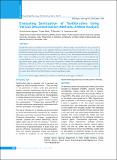Please use this identifier to cite or link to this item:
https://hdl.handle.net/20.500.14356/1461Full metadata record
| DC Field | Value | Language |
|---|---|---|
| dc.contributor.author | Agrawal, Santosh Kumari | - |
| dc.contributor.author | Dahal, Sirjana | - |
| dc.contributor.author | Bhumika, TV | - |
| dc.contributor.author | Nair, N. Sreekumaran | - |
| dc.date.accessioned | 2023-05-14T06:26:15Z | - |
| dc.date.available | 2023-05-14T06:26:15Z | - |
| dc.date.issued | 2018 | - |
| dc.identifier.citation | AgrawalS. K., DahalS., BhumikaT., & NairN. S. (2019). Evaluating Sanitization of Toothbrushes Using Various Decontamination Methods: A Meta-Analysis. Journal of Nepal Health Research Council, 16(41), 364-371. https://doi.org/10.33314/jnhrc.v16i41.1198 | en_US |
| dc.identifier.issn | Print ISSN: 1727-5482; Online ISSN: 1999-6217 | - |
| dc.identifier.uri | http://103.69.126.140:8080/handle/20.500.14356/1461 | - |
| dc.description | Review Article | en_US |
| dc.description.abstract | Abstract Toothbrushes play an essential role in personal oral hygiene by effective plaque removal.However, they get heavily contaminated by bacteria, viruses, yeasts, and fungi which may originate from the oral cavity after every use as well as from the environment where they are stored. This systematic review was conducted to identify various decontamination interventions attempted scientifically and it summarizes the efficacy of each. Meta-analysis illustrated that the use of Ultra-violet rays and Microwave had a significant effect on reduction of the microbial count of a used toothbrush with a mean difference of -2.61 and CI (-4.66,-0.76) with I2=98%. When compared with non-active treatment group, the natural agents (garlic, green tree and tea-tree oil) proved to sterilize the toothbrushes effectively with mean difference of -483.34, CI (-914.79, -51.88) and I2=100%.In contrast, chlorhexidine showed the insignificant result with a mean difference of -347.55 and CI (-951.90, 256.80) with I2=100%. The evidence from this review suggests that decontaminating toothbrush reduces bacterial load. Toothbrushes exposed to radiation and natural agents proved to sanitize them effectively but chlorhexidine rendered insignificant results. Keywords: Chemical agent; disinfection; radiation; microbial load; natural agent; toothbrush. | en_US |
| dc.language.iso | en | en_US |
| dc.publisher | Nepal Health Research Council | en_US |
| dc.relation.ispartofseries | Oct-Dec 2018; | - |
| dc.subject | Chemical agent | en_US |
| dc.subject | Disinfection | en_US |
| dc.subject | Radiation | en_US |
| dc.subject | Microbial load | en_US |
| dc.subject | Natural agent | en_US |
| dc.subject | Toothbrush | en_US |
| dc.title | Evaluating Sanitization of Toothbrushes Using Various Decontamination Methods: A Meta-Analysis | en_US |
| dc.type | Journal Article | en_US |
| local.journal.category | Review Article | - |
| Appears in Collections: | Vol. 16 No. 4 Issue 41 Oct - Dec 2018 | |
Files in This Item:
| File | Description | Size | Format | |
|---|---|---|---|---|
| 1198-Manuscript-7797-3-10-20190221.pdf | Fulltext Article. | 469.69 kB | Adobe PDF |  View/Open |
Items in DSpace are protected by copyright, with all rights reserved, unless otherwise indicated.
